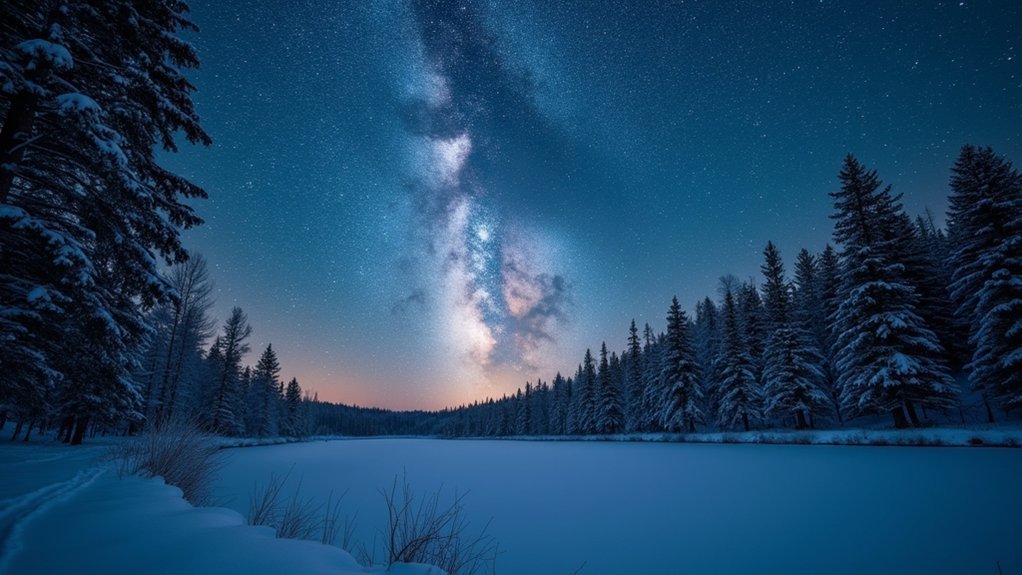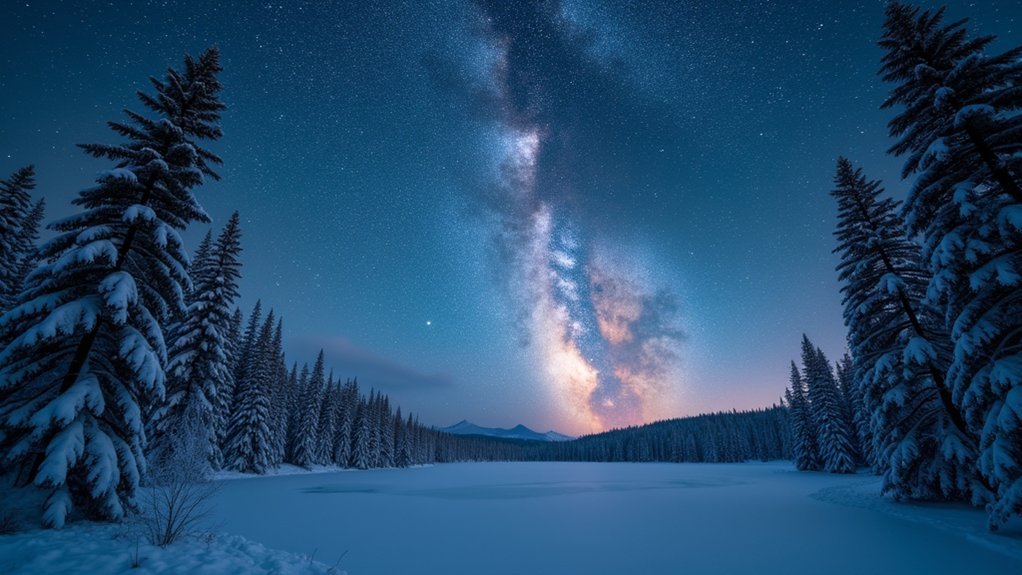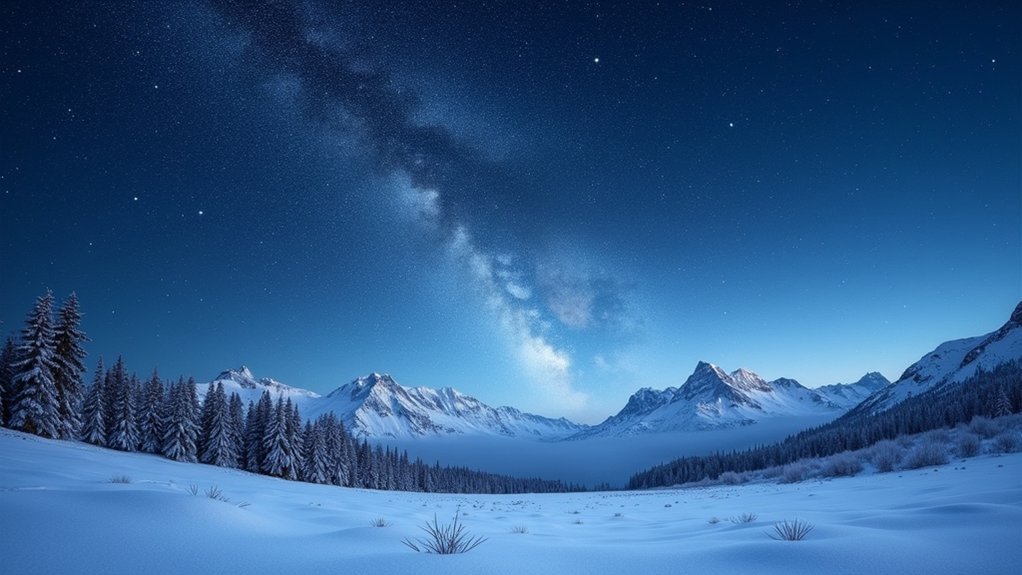For winter night sky photography, you’ll find exceptional conditions at Dark Sky Preserves like Big Bend and Joshua Tree National Parks, where you can capture roughly 2,000 stars on clear nights. Desert landscapes offer minimal light pollution, while mountain observation points reduce atmospheric interference. Frozen lakes create stunning reflective platforms that double celestial displays. National parks provide protected access with specialized programming during Winter Night Sky Festivals. Discover how these locations transform into natural astronomical theaters during the coldest months.
Dark Sky Preserves: Nature’s Winter Celestial Theaters

When winter’s cloak darkens the skies earlier each evening, Dark Sky Preserves transform into nature’s ultimate celestial theaters.
These protected dark sky locations offer you front-row seats to winter’s spectacular astronomical show, free from the interference of light pollution that plagues urban areas.
You’ll find premier spots like Big Bend and Joshua Tree National Parks perfectly positioned for astrophotography during clear night conditions.
The Milky Way, though positioned differently than in summer, remains visible against the pristine dark skies, alongside other breathtaking celestial phenomena.
Many preserves host Winter Night Sky Festivals where you can enhance your stargazing knowledge through educational programs.
The International Dark-Sky Association provides resources to help you identify these sanctuaries where you can witness the cosmos in its natural, awe-inspiring state.
Desert Landscapes for Pristine Winter Night Photography
Desert landscapes transform into remarkable winter astrophotography havens, offering you the perfect canvas for capturing the night sky at its most brilliant.
The minimal light pollution in areas like Big Bend allows you to photograph roughly 2,000 stars on clear nights. Joshua Tree National Park, a Silver Tier Dark Sky Park, combines unique granite formations with pristine skies, creating compelling compositional opportunities.
The winter desert’s clear, dry air produces sharper images with reduced atmospheric distortion, helping you capture detailed celestial objects with striking clarity.
- Use distinctive desert foreground elements like cacti and rock formations to add depth to your compositions
- Take advantage of the Milky Way and meteor showers visible in these pristine environments
- Visit during winter months when humidity is lowest for maximum image sharpness
Mountain Observation Points With Minimal Light Interference

Elevated far above urban light pollution, mountain observation points offer photographers unparalleled access to pristine night skies where celestial bodies shine with remarkable clarity.
Locations like Big Bend and Joshua Tree National Parks provide exceptional vantage points with minimal light pollution, ideal for winter astrophotography targets.
The Rocky Mountains boast prestigious dark sky designations, making them perfect for capturing the Milky Way against snow-capped peaks.
At high altitudes, sites like Mount Rainier and Mount Hood reduce atmospheric interference, enhancing visibility of faint celestial objects including the Andromeda Galaxy and Pleiades Star Cluster.
Plan your visit during new moon phases for maximum darkness.
You’ll find most mountain observation points accessible year-round, giving you countless opportunities to capture the winter night sky in its full splendor.
Frozen Lakes as Reflective Platforms for Star Imaging
Frozen lakes transform into nature’s perfect mirrors during winter months, offering photographers extraordinary platforms for capturing doubled celestial displays. The ice creates a unique reflective surface that enhances your astrophotography by producing symmetrical compositions of the night sky.
Winter’s clearer air reduces atmospheric distortion, resulting in sharper details of stars and the Milky Way.
- Position your camera during a New Moon to maximize the reflective quality of the ice while minimizing light interference
- Incorporate foreground elements like snow-covered trees or rocks to add depth and context to your composition
- Utilize the ice as a natural light diffuser that softens reflections and reduces glare from brighter celestial bodies
For truly mesmerizing shots, arrive before sunset to scout your location and prepare your equipment accordingly.
National Parks Offering Protected Winter Stargazing Access

Beyond frozen lakes, America’s national parks provide sanctuaries for winter astrophotographers seeking pristine dark skies. Big Bend National Park stands out with visibility of approximately 2,000 stars on clear winter nights, making it a premier destination for night sky photography in the contiguous US.
Joshua Tree’s Silver Tier Dark Sky Park status guarantees minimal light pollution, creating ideal conditions for capturing celestial events.
Meanwhile, the Boundary Waters Wilderness Canoe Area offers an impressive 16 hours of darkness during winter, perfect for photographing the Northern Lights.
You’ll find additional resources at National Parks’ winter Night Sky Festivals, which provide specialized programming for stargazing enthusiasts.
These protected areas, designated by the International Dark-Sky Association, let you witness the Milky Way with exceptional clarity during the cold, clear winter months.
Frequently Asked Questions
What Is the 500 Rule in Night Sky Photography?
The 500 rule helps you avoid star trails by dividing 500 by your lens’s focal length to determine maximum exposure time in seconds. You’ll capture stars as points rather than streaks in your photos.
Can You Do Astrophotography in Winter?
Yes, you can do astrophotography in winter! You’ll benefit from longer nights, reduced sensor noise in cold temperatures, and excellent winter constellations like Orion. Just dress warmly and protect your gear from condensation.
What ISO Setting for Night Sky Photography?
Start with ISO 1600-3200 for night sky photography. You’ll need to adjust based on your camera’s capabilities and light pollution levels. Higher-end cameras can use ISO 6400+ without significant noise for capturing faint celestial objects.
What Is the Best DSO for Winter?
The Orion Nebula is your best winter DSO target. It’s bright, easy to locate, and reveals stunning detail even with basic equipment. You’ll also love the Pleiades for its accessibility and beauty.
In Summary
You’ve now discovered five exceptional locations to capture winter’s stunning night sky. Whether you’re setting up on a frozen lake’s mirror-like surface or venturing into a dark sky preserve, you’ll find endless creative opportunities. Don’t let cold temperatures deter you—these pristine winter environments offer uniquely clear views that summer simply can’t match. Bundle up, bring extra batteries, and start planning your next stellar adventure.





Leave a Reply